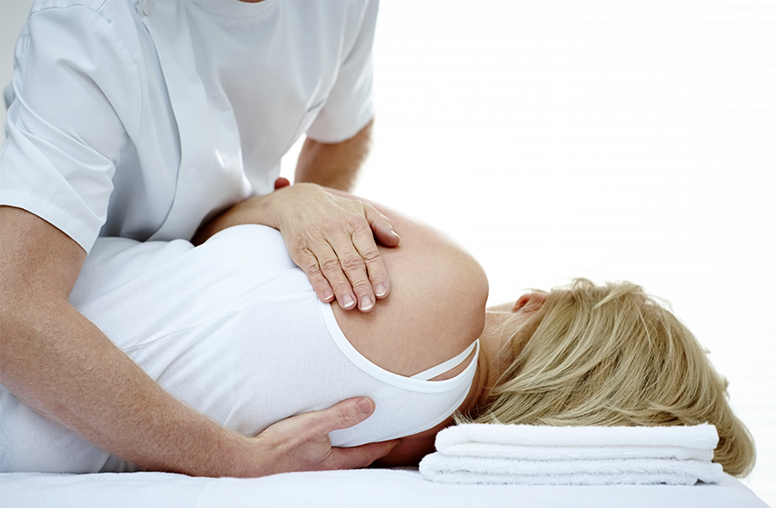Professional Treatment
Osteopathy
in London
Registered osteopaths providing hands-on treatments
to relieve pain,
improve mobility, and restore function.
GOsC regulated osteopathic experts
Evening & weekend appointments
Hundreds of satisfied patients

Restore mobility, relieve pain, and improve function with our professional osteopathic treatments
At Holistic Healthcare Clinics, our osteopathy services are delivered by experienced, registered practitioners who combine traditional osteopathic principles with modern evidence-based approaches. Whether you're suffering from back pain, joint issues, sports injuries, or seeking support for specific musculoskeletal conditions, our tailored approach ensures you receive the perfect treatment for your needs.
Our London clinic offers a range of osteopathic techniques including structural osteopathy, cranial osteopathy, visceral osteopathy, and sports osteopathy, all designed to address specific conditions and promote overall wellbeing through improved bodily function.
Choose the perfect osteopathic treatment for your specific needs
Our structural osteopathy focuses on diagnosing and treating problems in the body's framework through manual techniques that improve mobility and relieve pain. Particularly effective for treating:
Sessions typically last 45-60 minutes, with a thorough consultation before your first treatment to understand your health history and specific concerns.
Cranial osteopathy involves subtle, gentle techniques that work with the body's natural rhythms to release tensions throughout the body, starting from the head. This gentle approach is especially beneficial for:
Our practitioners use highly refined skills to detect subtle changes in tissue quality and tension patterns, promoting deep relaxation and healing.
Visceral osteopathy focuses on the internal organs and their surrounding structures, using gentle manipulation to improve organ function and mobility. This specialized technique is particularly effective for:
Treatment sessions address the complex relationships between organ function and musculoskeletal health, promoting better overall systemic function and relief from symptoms.
Sports osteopathy combines traditional osteopathic techniques with specialized knowledge of sports injuries and biomechanics to help athletes and active individuals. Ideal for:
Our sports osteopaths understand the unique demands placed on the body during various sports and activities, providing targeted care to address specific movement patterns and stresses.
Not sure which osteopathic treatment is right for you? Contact us for a free consultation or call 0207 526 4925
Our experienced osteopaths are skilled in addressing a wide range of musculoskeletal concerns
Osteopathy is highly effective for acute and chronic back and neck pain, including disc problems, sciatica, and postural issues through hands-on techniques that improve spinal mobility and function.
Our osteopathic treatments help address joint pain in shoulders, hips, knees, and other areas, improving range of motion and reducing pain through targeted manipulative techniques.
From muscle strains and ligament sprains to tendonitis and overuse injuries, our osteopaths help athletes recover quickly and safely while addressing the underlying biomechanical factors.
Whether caused by work habits, pregnancy, or daily activities, our osteopaths can identify and correct postural issues that lead to pain and dysfunction, providing relief and preventative strategies.
Many headaches have a musculoskeletal component that responds well to osteopathic treatment, addressing tensions in the neck, jaw, and cranial areas that contribute to head pain.
While osteopathy cannot cure arthritis, our gentle techniques can significantly improve mobility, reduce pain, and enhance quality of life for those with osteoarthritis, rheumatoid arthritis, and other joint conditions.
Holistic, hands-on care focused on your individual needs

Our osteopathic care begins with a comprehensive examination including medical history review, physical assessment, posture analysis, and when necessary, diagnostic imaging. This detailed approach allows us to identify the root causes of your symptoms rather than simply treating the pain.
We combine traditional osteopathic principles with the latest research and clinical evidence. Our treatment plans are designed to address your specific condition using techniques proven to be safe and effective for your particular needs.
Osteopathy recognizes that all parts of the body function together in an integrated manner. By addressing the relationships between structure and function, we help improve mobility, reduce pain, and enhance your body's natural ability to heal itself.
We work alongside our physiotherapists, massage therapists, and other practitioners when beneficial, creating integrated treatment plans that provide comprehensive care. This multidisciplinary approach ensures you receive the most effective combination of therapies for your condition.
Beyond in-clinic treatments, we emphasize patient education, providing guidance on posture, ergonomics, exercises, and lifestyle modifications that help maintain the benefits of osteopathic care and prevent future problems.
Specialized techniques tailored to your specific condition and preferences
Manual therapy applied to muscles, tendons, and ligaments to reduce tension, improve circulation, and enhance tissue mobility. These techniques include various forms of massage, stretching, and myofascial release to address soft tissue dysfunction.
Gentle mobilization of joints through their natural range of motion to improve mobility, reduce stiffness, and enhance function. These techniques help restore proper joint mechanics and relieve pain associated with restricted movement.
Precise, quick movements applied to joints that have become restricted in their movement. These techniques often produce the audible "click" associated with joint manipulation and help restore normal joint function and reduce pain.
Extremely gentle techniques that work with the subtle rhythms of the cranial bones and cerebrospinal fluid to release tensions throughout the body. Particularly beneficial for headaches, jaw problems, and stress-related conditions.
Gentle manipulation of the internal organs and their connective tissues to improve mobility and function. This specialized approach addresses restrictions that may be contributing to musculoskeletal pain and organ dysfunction.
A form of active stretching where you actively use your muscles from a controlled position against a counterforce provided by the osteopath. These techniques help improve joint mobility, stretch tight muscles, and strengthen weak ones.
A gentle technique involving positioning the body to relieve tension in specific tissues. The osteopath finds tender points, then positions the body in ways that shorten the affected muscles, allowing them to relax and reset.
Gentle guiding of joints through their functional movement patterns to identify and treat restrictions. These subtle techniques work with the body's natural movements to encourage release of tension and improved function.
Customized exercise programs designed to strengthen supporting muscles, improve flexibility, enhance stability, and prevent recurrence of problems. These exercises extend the benefits of in-clinic treatments and support long-term health.
All osteopathic treatments are delivered by fully qualified, GOsC-registered practitioners in a safe, comfortable environment using evidence-based approaches.
Book Your Osteopathy AssessmentHow osteopathy can improve your health and wellbeing through holistic manual therapy and evidence-based techniques
Osteopathic manipulative treatment addresses the root causes of pain by improving joint mobility, relieving muscle tension, and enhancing circulation to affected areas.
Osteopathic techniques help release physical tension patterns in the body, promoting relaxation of the nervous system and reducing the physical manifestations of stress.
Osteopathic techniques enhance blood and lymphatic flow throughout the body, promoting efficient delivery of nutrients and removal of waste products to support healing.
Osteopathy focuses on restoring optimal joint function and flexibility, helping you move more freely with less pain and greater range of motion in daily activities.
Osteopathy considers how all body systems are interconnected, addressing not just the symptoms but the underlying mechanical imbalances affecting your overall health.
Regular osteopathic treatment helps maintain optimal body function, identify potential issues before they worsen, and support your body's natural ability to stay healthy.
Read about the experiences of those we've helped

"After a car accident left me with chronic neck pain, I tried several treatments without success. The osteopathic approach at Holistic Healthcare Clinics addressed the underlying issues in my spine and posture, giving me lasting relief I hadn't found elsewhere."

"The cranial osteopathy treatment I received for my tension headaches was remarkable. I was skeptical at first, but the gentle techniques made a significant difference where medications had failed. My headache frequency has reduced dramatically."

"As a runner with recurring knee pain, I was worried my running days might be over. The osteopath identified issues not just in my knee but in my hip and foot alignment. The comprehensive treatment approach has me back to training pain-free."
Answers to common questions about osteopathic treatment
An osteopathic treatment typically involves:
Treatments are tailored to your specific needs and comfort level. Most sessions last 30-60 minutes, with follow-up treatments adjusted based on your progress.
The number of sessions required depends on several factors:
As a general guideline:
After your initial assessment, your osteopath will provide a personalized treatment plan with an estimated number of sessions. This plan is regularly reviewed and adjusted based on your progress.
Osteopathy is generally very safe when performed by qualified practitioners. At Holistic Healthcare Clinics, all our osteopaths are fully registered with the General Osteopathic Council (GOsC) and adhere to strict professional standards.
Most people experience minimal or no side effects, but temporary reactions may include:
These reactions are generally mild, short-lived, and considered a normal part of the healing process. Your osteopath will explain potential reactions specific to your treatment and provide advice on managing them.
During your initial consultation, we'll take a detailed medical history to ensure osteopathy is appropriate for your condition. There are some circumstances where certain techniques might be modified or avoided based on your health status.
Osteopathy works through several key principles and mechanisms:
Through these mechanisms, osteopathy helps address both symptoms and underlying causes of musculoskeletal issues, promoting long-term health rather than just temporary relief.
Before your session:
After your session:
Many people feel improvement immediately after treatment, while others may notice changes developing over several days. Either response is normal. If you have any concerns about your response to treatment, don't hesitate to contact your osteopath for advice.
Have other questions about osteopathy? Contact our team for personalized answers or book a consultation.
Book an appointment today and take the first step towards better health.